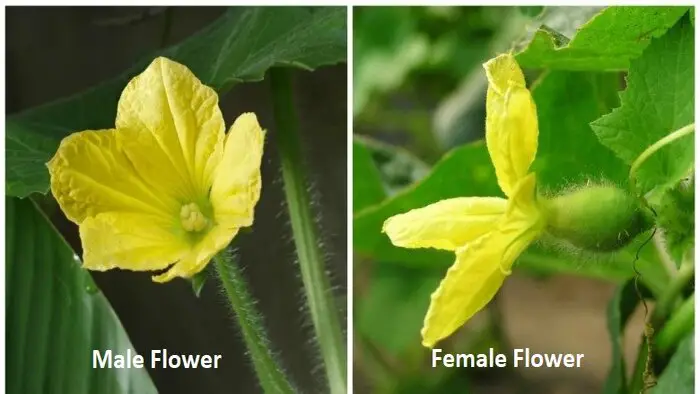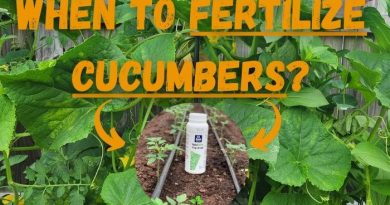Cucumber Not Flowering? Here’s How To Fix It!
Hey there fellow gardeners! Are you frustrated that your cucumber plants aren’t flowering? Don’t worry, we’ve got you covered! In this blog post, we’ll explore the most common reasons why cucumber plants may not be flowering and provide practical tips and solutions to help you encourage healthy, abundant flowers and fruit.
If your cucumber plant is not flowering, it may be due to a variety of factors, including insufficient light, poor pollination, or environmental stressors. To encourage flowering, make sure your cucumber plant is receiving at least 6 hours of direct sunlight per day, provide proper support for the plant, and avoid over-fertilizing. You can also try hand-pollinating your cucumber flowers using a small brush or cotton swab. By taking these steps, you can help your cucumber plant produce healthy, abundant flowers and fruit.
What is the flowering pattern in cucumber?
Cucumbers, like most cucurbit plants, produce separate male and female flowers on the same plant which in botanical terms means it is monoecious.
The male flowers typically appear first, followed by the female flowers a few weeks later. Most of the older varieties of cucumber are monoecious and tend to produce more male than female flowers.
This may be concerning to some, as the plants appear to be producing only male flowers, but the female flowers will start to develop a bit later so that when they are ready to be pollinated, viable pollen will already be present.
However many modern cucumber hybrids are gynoecious meaning they produce large numbers of female flowers and few, if any, male flowers. Gynoecious varieties produce a large number of female flowers and have a fairly concentrated flowering period.
| Early-Flowering Cucumber Varieties | Late-Flowering Cucumber Varieties |
|---|---|
| Diva | Lemon |
| Early Pik | Marketmore 76 |
| Salad Bush | Straight Eight |
| Spacemaster 80 | Suyo Long |
| Sweet Success | Armenian |
Reasons Cucumbers are Not Flowering
1. Irrigation with cold water
The most common reason why cucumbers do not bloom, namely the delay in the appearance of female flowers, is watering the plants with cold water. When cucumber plants are exposed to cold water, their growth can slow down, and may experience stress, which can lead to a reduction in flower production.
If the cucumbers are watered with cold water from the very beginning, then there are two options: either there will be no flowers at all, or they will be mostly empty flowers.
The transition of cucumber plants to flowering accelerates with a decrease in air and soil humidity.
This occurs as a result of the fact that:
- Turgor weakens;
- The outflow of carbohydrates from the leaves slows down significantly;
- There is a reduction in the intensity of photosynthesis;
- Cucumber growth is delayed.
Before flowering and during the period of growth of greens, the soil must be moistened regularly. But with the beginning of flowering, it is advisable to limit watering, because this will encourage the laying of more female flowers.
By this time the water for irrigation and the soil will have time to warm up well. But if watering is carried out in the afternoon, it is necessary that before darkness sets in, the soil has time to ventilate – by the evening its humidity should decrease.
Otherwise, the sun will burn wet leaves and soil. It is also not possible to pour cucumbers. All this time before flowering, while growth is taking place, regular watering is required.
But as soon as the cucumbers begin to bloom, it is limited so that as many female flowers as possible are laid. Watering restrictions are relevant at temperatures up to 80°F (27°C). If the temperature is above this mark, then watering should be continued in the same mode or even increased.
Treatment
Cucumbers should be watered only with warm and settled water, or with rain water. The water temperature should be about 77°F (25°C). Watering is carried out in the morning or in the evening, especially if it is watering the leaves.
It is recommended to water in the afternoon. Then both the soil and the water will be able to warm up enough. Cucumbers need to be moistened frequently, especially before flowering and during fruiting.
If the average air temperature reaches 80°F (27 °C), it is impossible to limit watering in any case. On the contrary, you can carry it out twice a day.
It is better to put a barrel on the edge of the garden in which the water will be heated in the sun.
Table with differences between male and female cucumber flowers

| Criteria | Male Cucumber Flower | Female Cucumber Flower |
|---|---|---|
| Appearance | Small and yellow | Large and yellow-green |
| Position on plant | Usually grows higher on the vine | Lower on the vine near the stem |
| Number of flowers produced | Produces more flowers | Produces fewer flowers |
| Function | Produces pollen | Produces fruit |
| Petals | Five petals | Five petals |
| Ovary | Absent | Present |
| Stamen | Longer and thinner | Shorter and thicker |
2. Low quality seeds
The lack of flowering in cucumbers is also related to the quality of the seeds. Bad or low-quality seeds can have a significant impact on the flowering of cucumber plants.
If the seeds are old or stored improperly for more than two or three years, they may not germinate or grow properly, which can result in stunted growth and reduced flower production.
If you’re new to gardening, you may not know that not all cucumber plants are suitable for collecting seeds from. This could result in disappointment if the seeds you collect will not grow and bloom into the type of cucumber plant you were expecting.
It is quite logical that you want to collect the seeds of such plants in order to subsequently use them for sowing. However, next year, for some reason, cucumbers do not bloom or give a large number of empty flowers.
Most often, this means that the plant used to collect the seeds was pollinated by a hybrid or was itself a hybrid. Since it is very difficult to control cross-pollination in a typical small area, it is best to buy seeds from reputable companies. Self-harvesting is, at first glance, quite simple, but risky.
If you still decide to try your luck, choose fruits with four seed chambers for harvesting seeds. They usually produce many female flowers.
Treatment
You need to pay special attention to the seeds you want to use for growing cucumbers. If you chose cucumber seeds that you did not grow, then make sure that these cucumbers were grown at home, otherwise, as a result, you may not get the vegetable that you have been eyeing so much.
Experienced gardeners may know or have noticed that a cucumber fruit has three or four seed chambers. If you still prefer to use the seeds of cucumbers not grown by yourself, we recommend that you take cucumbers with four chambers. As a rule, this type of cucumber blooms more.
Buy seeds from a proven agricultural company or grow only varietal cucumbers nearby and collect seeds from them.
3. Overcrowding
If you plant cucumbers too close together, they will not oxygenate well, they will not get enough sunlight, and nutrients will not be able to reach the roots in sufficient quantities. As a result, flowering will be later and weak, or perhaps no cucumber flowering at all.
Additionally, overcrowded plants are more likely to develop diseases or pests, which can also impact flower production.
If you have planted cucumbers too densely, do not be surprised at the large number of empty flowers. When cucumbers in the garden are crowded, this affects their development: they grow slowly, and flowers may not appear.
In addition, even with the appearance of flowers with an ovary, it is too early to breathe a sigh of relief: the thickening of the crops can prevent pollination.
Treatment
If your space is limited, try growing cucumbers on a trellis, or in barrels. These simple methods will allow you to use the available space more efficiently.
If you decide to grow cucumbers vertically, it is important to know that different varieties require a different approach. For plants on which male-type flowers are formed, it is desirable to pinch in the phase of 5-6 true leaves.
This will encourage side shoots with female flowers. In parthenocarpic varieties(no seeds) and hybrids, all cucumber shoots and buds that have appeared in the axils of 3-5 lower leaves are “blinded” (removed). This allows you to get rid of the ovaries that inhibit the development of the bush.
To promote healthy cucumber flowering, it’s important to give the plants enough space to grow and thrive: cucumber planting pattern (40 × 40 cm).
If your cucumbers are already planted in the ground, it remains only to “clear” the space between shoots as much as possible. To do this, pinch the main lash of seedlings. This will stop overgrowth and stimulate the appearance of female flowers.
4. Temperature Imbalance
Temperature can have a significant influence on the flowering of cucumber plants. Do not forget that cucumbers come from their southern regions, and the cold temperature can reduce flower production or even prevent flowers from forming altogether.
If the summer turns out to be abnormally cold, whether you like it or not, it will not be easy to get female flowers on cucumbers. In particular, if temperatures drop below 60°F (16°C) or exceed 95°F (35°C), it can significantly impact the plant’s ability to produce flowers.
Unfortunately, hot summer weather during the flowering of cucumbers can also adversely affect plant fertility. The air temperature above 80°F (27°C) in combination with dry air impairs pollination.
When it’s hot, a cucumber plant tends to produce more male flowers. At cooler temperatures, a cucumber plant produces more female flowers.
Treatment
Stop watering when the air temperature is below 60°F (15°C). This will stimulate the early formation of female flowers.
If you have the opportunity, build a temporary shelter for the cucumber bed. To do this, install arcs and protect the cucumber plantings with any covering material.
At temperatures below 59°F, cucumbers simply stop flowering, so in the cold regions of the world it makes sense to grow cucumbers in a greenhouse or under a film cover.
At high temperatures, meaning above (80°F), cucumbers need abundant watering, sprinkling and sun protection, and greenhouses need to be regularly ventilated.
5. Excess Fertilizer
We know that in the spring, cucumbers should be fed with nitrogen, but if there is too much of it, then there will be an active build-up of green mass, but the flowers will not appear.
This is because it encourages the plant to grow more leaves and stems, taking away energy that could be used for flowering.
As soon as flowering time approaches, nitrogen should be eliminated from the diet of cucumbers, and potassium should be added.
According to a study by Arshad et al. (2014), the application of NPK fertilizers as fertigation per plant can induce early flowering, fruiting, and picking with maximum number of fruits in cucumber.
Treatment
It is also important to apply fertilizer to the base level of the plant after it has produced blossoms, as scattering fertilizer on the plant can cause harmful effects.
| Nutrient | Function on Cucumbers | Necessary Quantity for Flowering |
|---|---|---|
| Nitrogen | Important for overall plant growth but too much can inhibit flower formation | 60-80 ppm |
| Phosphorus | Helps with root development and flower production. | 60-80 ppm |
| Potassium | Helps regulate water balance and supports strong stems and roots | 100-120 ppm |
| Magnesium | Helps with photosynthesis and protein synthesis | 20-40 ppm |
| Calcium | Helps with cell wall development and nutrient transport | 100-120 ppm |
| Zinc | Essential for enzyme function and growth hormone production | 0.5-1.0 ppm |
Signs of a Lack of Flowering in Cucumber Plants

- No flowers on the plant: If your cucumber plant is not producing any flowers, it may be too young to produce flowers or it may not be getting enough sunlight. Cucumber plants typically begin producing flowers 4-6 weeks after planting, so if your plant is younger than that, it may just need more time. If your plant is older than that and still not producing flowers, it may not be getting enough sunlight. Cucumber plants require at least 8 hours of sunlight per day to produce flowers and fruit.
- Few flowers on the plant: If your cucumber plant is producing only a few flowers, it may be due to poor pollination. Cucumber plants require pollinators, such as bees, to transfer pollen from the male flowers to the female flowers. If there are not enough pollinators in your garden, you can try hand-pollinating the flowers using a small paintbrush.
- Flowers falling off the plant: If your cucumber plant is producing flowers but they are falling off before they can develop into fruit, it may be due to high temperatures or low humidity levels. Cucumber plants prefer temperatures between 70-85°F and humidity levels between 50-70%. If the temperatures are too high or the humidity levels are too low, the flowers may not be able to develop properly.
- Flowers turning brown or yellow: If your cucumber plant is producing flowers but they are turning brown or yellow, it may be due to poor soil quality or lack of nutrients. Cucumber plants require well-draining soil with plenty of organic matter and nutrients. If the soil is poor quality or lacking in nutrients, the flowers may not be able to develop properly.
- Flowers appearing but no fruit developing: If your cucumber plant is producing flowers but no fruit is developing, it may be due to a lack of pollination or improper fertilization. Make sure that the flowers are being pollinated properly and that you are fertilizing the plant regularly with a balanced fertilizer, such as 10-10-10.
How to help cucumber bloom
| Requirements | Description |
|---|---|
| Light | Cucumbers require at least 6 hours of full sunlight daily to flower. |
| Temperature | Cucumbers prefer warm temperatures between 70-85°F (21-29°C) during the day and 60-70°F (16-21°C) at night. |
| Water | Cucumbers require consistent moisture to flower. Avoid overwatering or letting the soil dry out completely. |
| Fertilizer | Use a balanced fertilizer (with equal amounts of nitrogen, phosphorus, and potassium) to provide essential nutrients. Avoid over-fertilizing, which can inhibit flowering. |
| Pollination | Cucumbers require adequate pollination from bees or other pollinators to set fruit. |
| Pruning | Prune excess foliage to promote air circulation and prevent overcrowding, which can inhibit flowering. |
| Variety | Choose a cucumber variety that is well-suited to your growing conditions and has a reputation for good flowering and fruiting. |
Frequently Asked Questions
You can encourage your cucumber plants to bloom by providing adequate sunlight, consistent moisture, proper nutrition, and hand pollinating if pollinators are scarce in your area.
Flowering in early ripening varieties begins 30-35 days after germination, and in late varieties – 35-45 days. In early-ripening varieties and hybrids, female and male flowers appear almost simultaneously, in late-ripening varieties, male and then female flowers bloom first.
Yes, it is normal for cucumber plants to not bloom early in the season as they require a certain amount of growth and development before they can produce flowers and fruit.
Cucumber plants have a flowering pattern where male flowers appear first, followed by female flowers a few weeks later. Older cucumber varieties tend to produce more male flowers, while modern hybrids produce more female flowers.
To encourage the first blooms on cucumber plants, it is important to moisten the soil regularly before flowering and limit watering once flowering begins. Watering should be done with warm and settled water, or rainwater, at a temperature of about 77°F (25°C).




